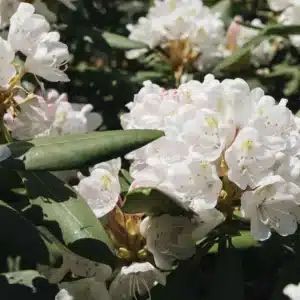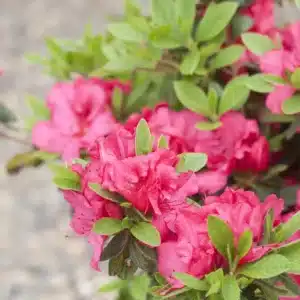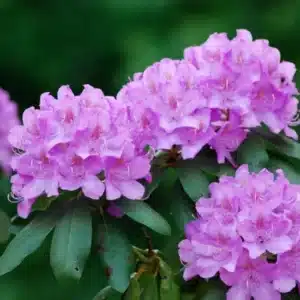Rhododendrons, Azaleas






Azaleas prefer moist, well-drained, acidic soils, rich in organic matter. Azaleas do not tolerate “wet feet” which often occurs in dense clay soils; clay soils require amending with organic matter, such as composted cow manure, chopped leaves or a rich compost. If buying from a nursery choose larger plants in 1- or 3-gallon pots with deeper root systems. Space plants 2 to 6 feet apart, depending on their mature size. Dig a hole as deep as the root ball and twice as wide. In heavy clay soils, good drainage may be enhanced by planting Azaleas with the tops of their root balls a few inches above ground level and mounding the soil up to the plants. Most Azaleas prefer morning sun and afternoon shade, but some varieties do well in full sun, especially deciduous types. While more sun typically produces more compact plants with more blooms, the blooms will not last as long. Areas located in the warmer end of the growing zones, should choose a site that gets afternoon shade. Azaleas may be transplanted at any time during the growing season, but they transplant most successfully during fall or early spring, when they are dormant and temperatures are cool. Layer an organic mulch over the root ball to keep moisture in the ground, maintain soil temperature, and enrich the soil as it decomposes. Take care to keep the mulch a couple of inches away from the main stem. Azaleas may be propagated from seed, under controlled conditions, but this process is tedious and takes 12-18 months to develop a viable shrub. Cuttings of the stems of most evergreen Azaleas can be rooted and propagated rather easily; however, cuttings of deciduous Azaleas are more difficult to root. All Azaleas may be successfully propagated by layering, or using a cutting that remains attached to the parent until roots have formed. To propagate by layering, find a branch that can be bent to the ground, dig a shallow trench an inch or two deep in the direction of the branch, and bend the branch down to put it into the trench. Cover at least a few inches of the branch in the trench with good soil; you may need to anchor the branch with a U-wire or brick. In about 12 months, the branch will have grown roots, and may be cut loose from the parent plant.
Azaleas develop rather shallow, slow-growing root systems and may require supplemental watering through early fall, until the plants are established. The amount of water needed depends on the soil, temperature, humidity, wind and sunlight. Good soil drainage is essential. An infrequent deep soaking is more effective than superficial sprinkling to encourage proper root growth. Adequate water after blooming helps to produce more flower buds for next year, as a lack of water reduces flower-bud formation. In a dry fall, water heavily after a good frost, before cold weather sets in. Mulch plants every spring to protect shallow roots and retain soil moisture, and in the winter to protect roots from freeze. Pine straw and pine bark acidify the soil as they decompose, so pine-based mulches enrich the soil ideally for acid-loving Azaleas. Always leave a few inches around the trunk free of mulch.
Established Azaleas do not need fertilizer. If a soil test indicates the need for a fertilizer use one that is especially formulated for Azaleas. Fertilize these plants sparingly and only when flower buds swell in the early spring, even if they are fall bloomers. Heavy applications of fertilizer will burn the plants. Never fertilize after July 1st, to avoid inducing new growth which may be killed in the winter. Azaleas prefer acidic soils with a pH of 5.0-6.0. To lower the pH of extremely alkaline soils prepare a mixture of 3 parts garden sulfur to 1 part iron sulfate, then apply it at the rate of 1 pound per 100 sq. ft. of garden bed. This should lower the pH by one point to aid in achieving the desired range of 5.0–6.0.
Pruning Azaleas is a personal preference. Many gardeners choose to avoid pruning Azaleas and and prefer letting them sprawl into their beautiful, natural, rambling shape. Others choose to trim them back for a tidier look and space requirements. In general, if needed to reduce height or width, prune soon after flowering in the spring to avoid cutting off next year’s flower buds. Be careful not to damage growth buds at the base of each flower stalk. New flower buds for next year’s blooms are set by midsummer, so early pruning is recommended. Removing dead or diseased branches may be done at any time.
Azaleas are relatively pest-free, forgiving and easy to grow plants. Occasionally, “petal blight”, a fungal disease that appears as discolored dots on the petals may occur. An organic fungicidal spray in the spring will help treat this disease. Lacebugs and spider mites may find Azaleas an attractive target. The insects are usually not a problem, but may be removed by spraying with high-pressure water, or a natural insecticidal soap. Always read and follow label directions on all horticultural products. Fungal root rot can occur in damp, heavy soils. Avoid overwatering, and plant in a well-drained location to help prevent this condition.











